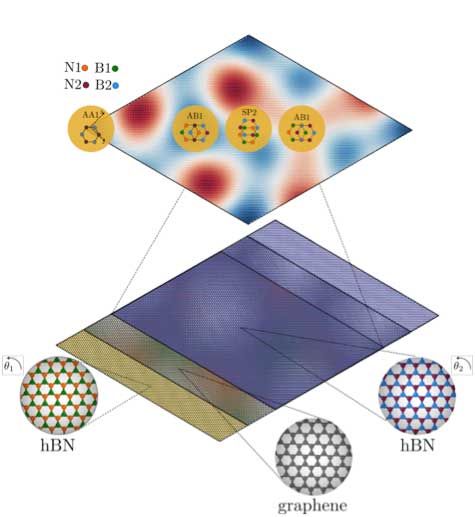
hotline:
17715390137
Tel/Wechat:
18101240246 (Technology)
0512-68565571
Email:mxenes@163.com (Sales Engineer)bkxc.bonnie@gmail.com
Scan the code to follow or search the official account on WeChat:
2D Materials Fronrier After paying attention,
click on the lower right corner to contact us,
Enter enterprise WeChat.
Professional Services Online

 (Nanowerk Spotlight) Researchers at the University of Antwerp explain how high-order super-Mohr modulation due to the encapsulation of graphene between hexagonal boron nitride affects the electronic and structural properties of graphene, as revealed by three recent independent experiments Like that.
(Nanowerk Spotlight) Researchers at the University of Antwerp explain how high-order super-Mohr modulation due to the encapsulation of graphene between hexagonal boron nitride affects the electronic and structural properties of graphene, as revealed by three recent independent experiments Like that.
High-quality graphene samples are important to obtain and take advantage of their theoretically described properties. The use of a suitable substrate can reduce ripples and improve the disordered confinement performance of graphene.
Hexagonal boron nitride (hBN) is a particularly good choice because it perfectly preserves the graphene structure while providing a flat insulating surface. However, this only works if the two single layers are misaligned. Otherwise, the van der Waals interaction causes structural relaxation on the scale of the Moire pattern formed between the two layers and changes the electronic properties due to the periodic Moire disturbance.
A similar argument applies if graphene is encapsulated and closely aligned with the two hBN layers. In this case, since both layers are expected to work, the effect is enhanced. In addition, the close alignment of the layers (about 0.5 degrees) has led to a new form of periodic supermoiré modulation, which will change graphene on a larger spatial scale, but on an energy scale It will be smaller.
Recent experimental observations of this effect are the results of significant improvements in experimental manipulation techniques, including those that can rotate a single layer with high accuracy (Wang et al., 2019a; Wang et al., 2019b; Finney et al., 2019 – see the end of this article Reference).

Schematic diagram of bond relaxation (top) and hBN / graphene / hBN heterostructure in the graphene layer of the ultra-Moore cell (bottom).
Anđelković et al. In their recent paper published in Nano Letters ("Twisted Double Moire Fringe: Super Moire in Encapsulated Graphene"). It reveals the conditions under which the super moire effect occurs and how it changes the structure and electronic properties of graphene.
They show how starting from rigid hBN / graphene / hBN heterostructures, super ripples appear as simple geometric considerations.
In addition, they demonstrated that the relaxation effect of the three layers is expected to enhance the effect on the electronic band structure. The changes caused by the Super Moire fringe are very important: the emergence of new low-energy flat subbands and Dirac points, which have a strong influence on the electron transport performance. In most configurations, Dirac points are gapped, while flat bands are expected to enhance electron-electron correlation.
Dr. Lucian Covaci said: "These new twisting degrees of freedom in heterostructures open up new basic research directions for graphene. In graphene, strong electron correlation is expected to complement the highest level of properties that graphene already has."
"A set of multi-scale numerical simulations developed by the research team at the University of Antwerp allows for more realistic models, which will in turn allow a more direct comparison with experimental observations," said Dr. Misa Anđelković‘s co-developers, Pybinding, a tightly integrated open source Software makes simulation possible.
With people‘s understanding of the more complex and disturbing behavior of van der Waals‘ heterostructures, new highlights can be used to fine-tune the electronic properties of graphene and reach the state in which phenomena caused by distortion (such as the appearance of flat bands or small gaps) appear More clearly.
references
NR Finney et al. (2019). "The tunable crystal symmetry of the Mohr superlattice also exists in the graphene-boron nitride heterostructure". In: Nat. nanotechnology. 14.11, pp. 1029-1034.
L. Wang et al. (2019a). "A new generation of Mohr superlattices in a dual-aligned hBN / graphene / hBN heterostructure." In: Nano. Come on 19.4, pages 2371–2376.
Z. Wang et al. (2019b). "Composite Ultra-Moore Grids in Double-Aligned Graphene Heterostructures." In: Science. Advanced 5.12, eaay8897.
信息来源:nanowerk

| Reminder: Beijing Beike New Material Technology Co., Ltd. supplies products only for scientific research, not for humans |
| All rights reserved © 2019 beijing beike new material Technology Co., Ltd 京ICP备16054715-2号 |